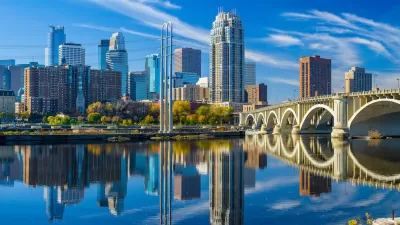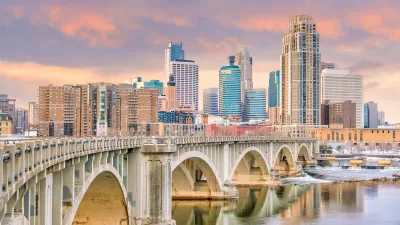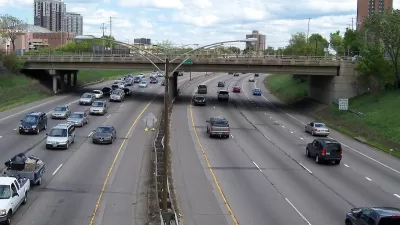Could the nascent plan for Gateway Park satiate Minneapolitans suffering from downtown park envy?
The benefits of a signature park located in downtown Minneapolis to civic pride, attracting young professionals, and economic development are clear, writes Marlys Harris. Besides, "[a]ll the very best cities have one." The most promising prospect is being championed by Minneapolis civic and business leaders involved in the Trust for Public Land, who since 2008 have "been jonesing for a major park in the city's core."
"The plan that has evolved is Gateway Park," says Harris, "which would stretch from 5th Street to the Mississippi. In a way, it's more a green corridor with lots of trees lining Hennepin and Nicollet to hook up two major splotches of actual park. The first would unite Cancer Survivors Park between Second and Third Streets with a now-empty lot next to the Main Library... Two triangles of land fronting Hennepin would provide passageways to a second large patch on Hennepin and First Street that would terrace down to the waterfront below."
According to Harris, "[p]ractically everybody in town has signed on to the plan: the Minneapolis Downtown Council, the mayor, the steering committee which includes leaders from Target, Piper Jaffray, the Pohlad Family Companies, the Minneapolis Planning Commission and the Parks and Recreation Board."
However obstacles remain. "The main problem may be that no official government body seems to 'own' the project. The Downtown Council and the Trust for Public Land are its 'champions,' says [Bruce Chamberlain, assistant superintendant for planning services for Park and Recreation]. But the Park Board sees Gateway as an adjunct to its own agenda to develop the riverfront from downtown to the city's northern border."
FULL STORY: Gateway Park: When will Minneapolis get a signature downtown park?

Manufactured Crisis: Losing the Nation’s Largest Source of Unsubsidized Affordable Housing
Manufactured housing communities have long been an affordable housing option for millions of people living in the U.S., but that affordability is disappearing rapidly. How did we get here?

Americans May Be Stuck — But Why?
Americans are moving a lot less than they once did, and that is a problem. While Yoni Applebaum, in his highly-publicized article Stuck, gets the reasons badly wrong, it's still important to ask: why are we moving so much less than before?

Using Old Oil and Gas Wells for Green Energy Storage
Penn State researchers have found that repurposing abandoned oil and gas wells for geothermal-assisted compressed-air energy storage can boost efficiency, reduce environmental risks, and support clean energy and job transitions.

Greening Oakland’s School Grounds
With help from community partners like the Trust for Public Land, Oakland Unified School District is turning barren, asphalt-covered schoolyards into vibrant, green spaces that support outdoor learning, play, and student well-being.

California Governor Suspends CEQA Reviews for Utilities in Fire Areas
Utility restoration efforts in areas affected by the January wildfires in Los Angeles will be exempt from environmental regulations to speed up the rebuilding of essential infrastructure.

Native American Communities Prepare to Lead on Environmental Stewardship
In the face of federal threats to public lands and conservation efforts, indigenous groups continue to model nature-centered conservation efforts.
Urban Design for Planners 1: Software Tools
This six-course series explores essential urban design concepts using open source software and equips planners with the tools they need to participate fully in the urban design process.
Planning for Universal Design
Learn the tools for implementing Universal Design in planning regulations.
Heyer Gruel & Associates PA
City of Moreno Valley
Institute for Housing and Urban Development Studies (IHS)
City of Grandview
Harvard GSD Executive Education
Salt Lake City
NYU Wagner Graduate School of Public Service
City of Cambridge, Maryland





























